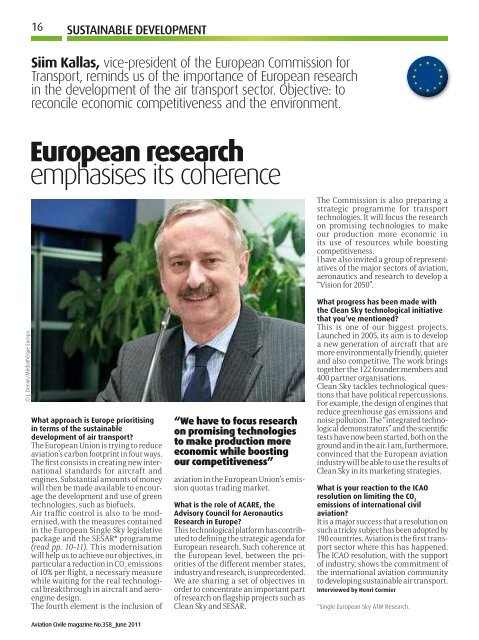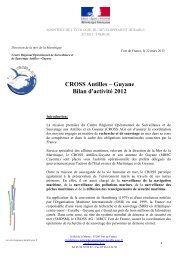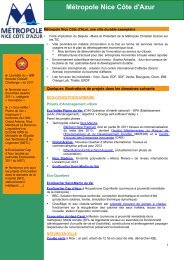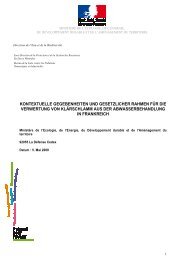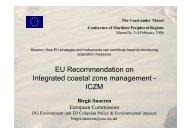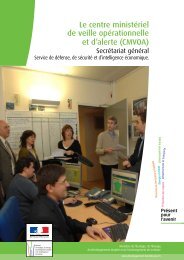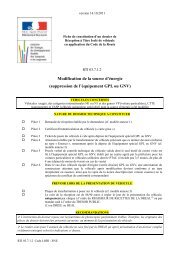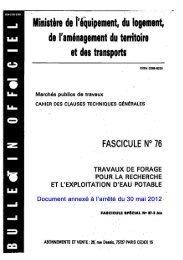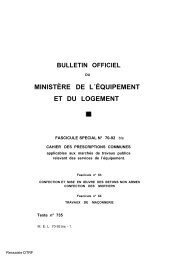Aviation Civile
Aviation Civile
Aviation Civile
Create successful ePaper yourself
Turn your PDF publications into a flip-book with our unique Google optimized e-Paper software.
© J. Denier/Médiathèque Europa<br />
16 SuSTAINAbLE DEVELoPMENT<br />
VERy ACTIVE INTERNATIoNAL CooPERATIoN 17<br />
siim Kallas, vice-president of the European Commission for<br />
Transport, reminds us of the importance of European research<br />
in the development of the air transport sector. Objective: to<br />
reconcile economic competitiveness and the environment.<br />
european research<br />
emphasises its coherence<br />
what approach is Europe prioritising<br />
in terms of the sustainable<br />
development of air transport?<br />
The European Union is trying to reduce<br />
aviation’s carbon footprint in four ways.<br />
The first consists in creating new international<br />
standards for aircraft and<br />
engines. Substantial amounts of money<br />
will then be made available to encourage<br />
the development and use of green<br />
technologies, such as biofuels.<br />
Air traffic control is also to be modernised,<br />
with the measures contained<br />
in the European Single Sky legislative<br />
package and the SESAR* programme<br />
(read pp. 10-11). This modernisation<br />
will help us to achieve our objectives, in<br />
particular a reduction in CO 2 emissions<br />
of 10% per flight, a necessary measure<br />
while waiting for the real technological<br />
breakthrough in aircraft and aeroengine<br />
design.<br />
The fourth element is the inclusion of<br />
“we have to focus research<br />
on promising technologies<br />
to make production more<br />
economic while boosting<br />
our competitiveness”<br />
aviation in the European Union’s emission<br />
quotas trading market.<br />
what is the role of ACArE, the<br />
Advisory Council for Aeronautics<br />
research in Europe?<br />
This technological platform has contributed<br />
to defining the strategic agenda for<br />
European research. Such coherence at<br />
the European level, between the priorities<br />
of the different member states,<br />
industry and research, is unprecedented.<br />
We are sharing a set of objectives in<br />
order to concentrate an important part<br />
of research on flagship projects such as<br />
Clean Sky and SESAR.<br />
The Commission is also preparing a<br />
strategic programme for transport<br />
technologies. It will focus the research<br />
on promising technologies to make<br />
our production more economic in<br />
its use of resources while boosting<br />
competitiveness.<br />
I have also invited a group of representatives<br />
of the major sectors of aviation,<br />
aeronautics and research to develop a<br />
“Vision for 2050”.<br />
what progress has been made with<br />
the Clean sky technological initiative<br />
that you’ve mentioned?<br />
This is one of our biggest projects.<br />
Launched in 2005, its aim is to develop<br />
a new generation of aircraft that are<br />
more environmentally friendly, quieter<br />
and also competitive. The work brings<br />
together the 122 founder members and<br />
400 partner organisations.<br />
Clean Sky tackles technological questions<br />
that have political repercussions.<br />
For example, the design of engines that<br />
reduce greenhouse gas emissions and<br />
noise pollution. The “integrated technological<br />
demonstrators” and the scientific<br />
tests have now been started, both on the<br />
ground and in the air. I am, furthermore,<br />
convinced that the European aviation<br />
industry will be able to use the results of<br />
Clean Sky in its marketing strategies.<br />
what is your reaction to the ICAo<br />
resolution on limiting the Co 2<br />
emissions of international civil<br />
aviation?<br />
It is a major success that a resolution on<br />
such a tricky subject has been adopted by<br />
190 countries. <strong>Aviation</strong> is the first transport<br />
sector where this has happened.<br />
The ICAO resolution, with the support<br />
of industry, shows the commitment of<br />
the international aviation community<br />
to developing sustainable air transport.<br />
Interviewed by henri Cormier<br />
*Single European Sky ATM Research.<br />
<strong>Aviation</strong> <strong>Civile</strong> magazine No.358_ June 2011 <strong>Aviation</strong> <strong>Civile</strong> magazine No.358_ June 2011<br />
© Thinkstock 2011<br />
The central mission of the DGAC is<br />
to improve the safety of air transport.<br />
International cooperation work<br />
contributes fully to this, consisting<br />
in providing foreign civil aviation<br />
authorities with technical support<br />
and undertaking training programmes<br />
at their request. Through this approach,<br />
the DGAC ensures not only the promotion<br />
of its know-how but also that of French<br />
and European industry, thanks to the<br />
International cooperation mission team.<br />
This unit works closely with the experts<br />
of the DGAC, the National Civil <strong>Aviation</strong><br />
School (ENAC), the Civil <strong>Aviation</strong> Safety<br />
Research and Analysis office and<br />
the General Council of the Environment<br />
and Sustainable Development.<br />
The mission also relies on a network<br />
of aeronautics attachés at the French<br />
embassies in brazil, China, Russia<br />
and India. With permanent links with<br />
the International Cooperation mission,<br />
these aeronautics “ambassadors”<br />
are in daily contact with their local<br />
interlocutors. They have precious<br />
knowledge of the organisation and<br />
functioning of the foreign<br />
administrations and markets and this<br />
is vital for the success of DGAC technical<br />
support operations and informing<br />
French industry. The Sino-European<br />
institute of civil aviation engineering<br />
of Tianjin, set up in 2007, and<br />
the introduction in India of new flight<br />
procedures are good examples of<br />
the results.<br />
Élisabeth Dallo<br />
Directorate general for Civil <strong>Aviation</strong><br />
Directorate of Air Transport<br />
Director of the International<br />
Cooperation Mission<br />
A network of expertise


